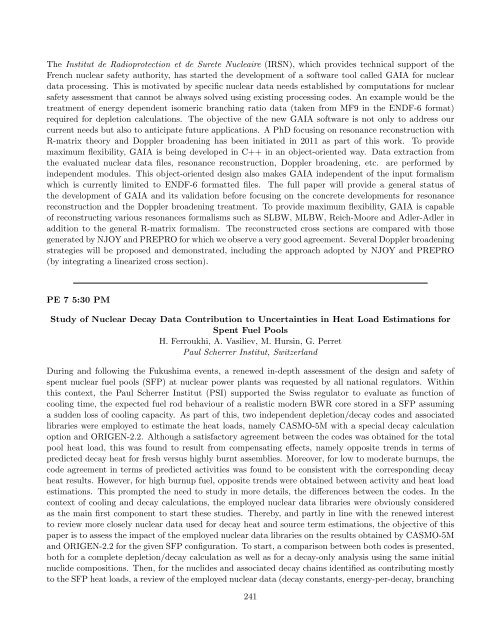Program - Brookhaven National Laboratory
Program - Brookhaven National Laboratory
Program - Brookhaven National Laboratory
You also want an ePaper? Increase the reach of your titles
YUMPU automatically turns print PDFs into web optimized ePapers that Google loves.
The Institut de Radioprotection et de Surete Nucleaire (IRSN), which provides technical support of the<br />
French nuclear safety authority, has started the development of a software tool called GAIA for nuclear<br />
data processing. This is motivated by specific nuclear data needs established by computations for nuclear<br />
safety assessment that cannot be always solved using existing processing codes. An example would be the<br />
treatment of energy dependent isomeric branching ratio data (taken from MF9 in the ENDF-6 format)<br />
required for depletion calculations. The objective of the new GAIA software is not only to address our<br />
current needs but also to anticipate future applications. A PhD focusing on resonance reconstruction with<br />
R-matrix theory and Doppler broadening has been initiated in 2011 as part of this work. To provide<br />
maximum flexibility, GAIA is being developed in C++ in an object-oriented way. Data extraction from<br />
the evaluated nuclear data files, resonance reconstruction, Doppler broadening, etc. are performed by<br />
independent modules. This object-oriented design also makes GAIA independent of the input formalism<br />
which is currently limited to ENDF-6 formatted files. The full paper will provide a general status of<br />
the development of GAIA and its validation before focusing on the concrete developments for resonance<br />
reconstruction and the Doppler broadening treatment. To provide maximum flexibility, GAIA is capable<br />
of reconstructing various resonances formalisms such as SLBW, MLBW, Reich-Moore and Adler-Adler in<br />
addition to the general R-matrix formalism. The reconstructed cross sections are compared with those<br />
generated by NJOY and PREPRO for which we observe a very good agreement. Several Doppler broadening<br />
strategies will be proposed and demonstrated, including the approach adopted by NJOY and PREPRO<br />
(by integrating a linearized cross section).<br />
PE 7 5:30 PM<br />
Study of Nuclear Decay Data Contribution to Uncertainties in Heat Load Estimations for<br />
Spent Fuel Pools<br />
H. Ferroukhi, A. Vasiliev, M. Hursin, G. Perret<br />
Paul Scherrer Institut, Switzerland<br />
During and following the Fukushima events, a renewed in-depth assessment of the design and safety of<br />
spent nuclear fuel pools (SFP) at nuclear power plants was requested by all national regulators. Within<br />
this context, the Paul Scherrer Institut (PSI) supported the Swiss regulator to evaluate as function of<br />
cooling time, the expected fuel rod behaviour of a realistic modern BWR core stored in a SFP assuming<br />
a sudden loss of cooling capacity. As part of this, two independent depletion/decay codes and associated<br />
libraries were employed to estimate the heat loads, namely CASMO-5M with a special decay calculation<br />
option and ORIGEN-2.2. Although a satisfactory agreement between the codes was obtained for the total<br />
pool heat load, this was found to result from compensating effects, namely opposite trends in terms of<br />
predicted decay heat for fresh versus highly burnt assemblies. Moreover, for low to moderate burnups, the<br />
code agreement in terms of predicted activities was found to be consistent with the corresponding decay<br />
heat results. However, for high burnup fuel, opposite trends were obtained between activity and heat load<br />
estimations. This prompted the need to study in more details, the differences between the codes. In the<br />
context of cooling and decay calculations, the employed nuclear data libraries were obviously considered<br />
as the main first component to start these studies. Thereby, and partly in line with the renewed interest<br />
to review more closely nuclear data used for decay heat and source term estimations, the objective of this<br />
paper is to assess the impact of the employed nuclear data libraries on the results obtained by CASMO-5M<br />
and ORIGEN-2.2 for the given SFP configuration. To start, a comparison between both codes is presented,<br />
both for a complete depletion/decay calculation as well as for a decay-only analysis using the same initial<br />
nuclide compositions. Then, for the nuclides and associated decay chains identified as contributing mostly<br />
to the SFP heat loads, a review of the employed nuclear data (decay constants, energy-per-decay, branching<br />
241
















